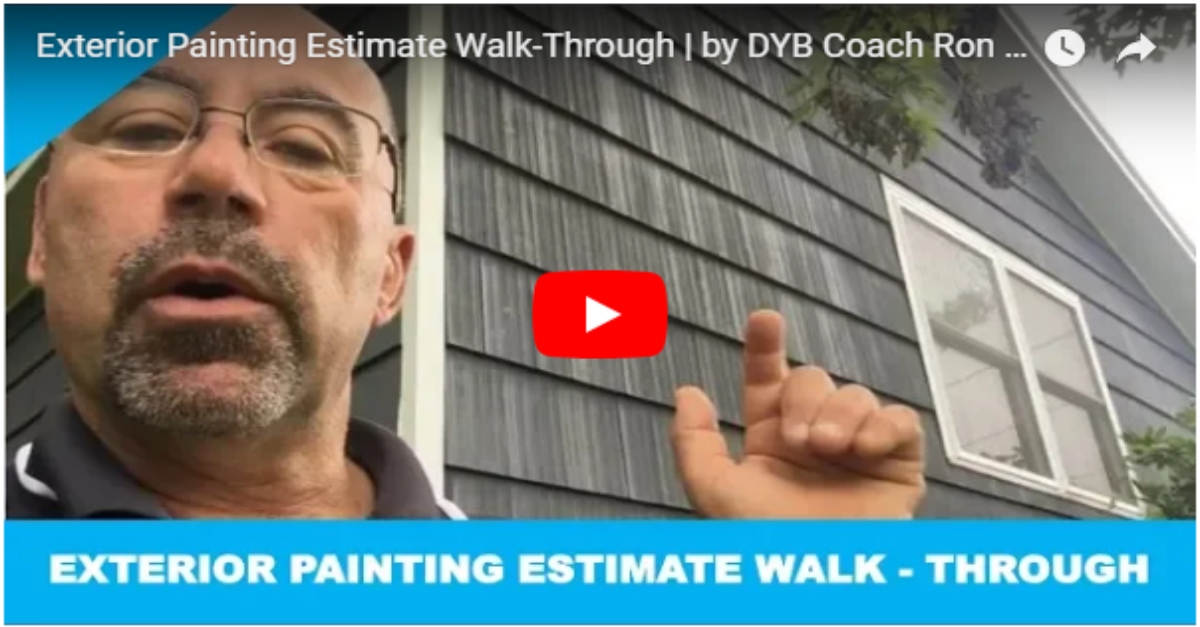
Exterior Painting Estimate Walk-Through
Exterior estimates; How do we do them? What do we look for?
And sometimes additional charges or additional work orders (AWOs) that we can actually pass on to the customer.
I am Ron Ramsden and I am a DYB coach, also a painting contractor.
Here on a job site, we are actually at a small ranch in Massachusetts, we are not touching the siding, but we are doing the trim, and doing a lot of wood repairs.
So, as I walk through this, I am going to point out a few things, additional work orders that were added to the job and how we bid this.
So, it’s a small ranch and I guess we are only doing all the trim. How do we price this?
Pricing this by linear foot would be really tough, only because of the wood repair and the amount of work that we found.
One of the options is time and material, and I know that is a tough sell to a lot of customers, if you are pricing at $45, $50, $60, $65, $70 an hour, the homeowner is going to quickly add that up and say, oh no, I can’t afford it.
So, what we do is, we actually take a walk around and we are just going to do the front.
We have all the surface to do and we have the woodwork around the window, we are not doing any of the basement walls, but they do need work.
What I did is I gave that a line item price – I measured out the square footage of the foundation, figured out how many hours it was going to take us to scrape it using a mercenary primer and then a coat of white paint.
That turned into about 7 hours’ worth of work, so you get out with a gallon of paint, a quarter primer and I gave a line item price for that.
They weren’t asking for that, but I was on the job site when I did my initial walkthrough for the estimate, so I gave that a line item.
They decided not to do that, which is perfectly fine, but their price is always good for 6 months or however, you keep your pricing good for.
Also, the stairs were rotten, well, they weren’t really rotten, but they were in a really bad shape.
There is also a ceiling over the small porch and there is nothing on the stairs, so the stairs really took a beating.
We actually gave them two options; we gave them the price of scrapping it down, priming it and painting it or another price of just replacing that riser as well as the pressure treated wood and the pricing was actually not that different for the new.
Actually, what added the additional cost was the transportation fee to get rid of all the extra wood, but because we had extra wood everywhere else and we only had one dump… so, that was a given.
Right now, we put 3 hours into scraping and sanding the railings and it is a little bit of a guess because you don’t know what you are running into.
But I figured 3 hours with the experience of the crew, the guys who would be doing it, that would be something, and this is something an apprentice would be on –an apprentice being a new painter from one of the industries, who wants a change.
They jump on things like this, we help them out, we show them what to do, every now and then we walk by, make sure they are not on the phone and things like that.
So, 3 hours, we have to stain this instead of painting them and the rises will get primed and painted.
Right here we have about a half hour over, you start adding that, you are going to take 2 hours, 3 hours and then more.
As we walk here, you are going to see, right behind me, that’s the discovery.
There was a gutter right there and all behind the gutter was a rod, so we had to replace the wood on that side, what is the price of wood, an hour for that to be fixed, and we could not get a carpenter over here for one hour.
We tend to break everything up in half days because of the setup and cleanups. Carpenters do get paid much more than a painter, at least the crew leaders, they get about the same but the charge for the homeowner is much more expensive than a regular painter would be on the job site.
Right here, you can probably wrap this whole front painting, prep, and priming for about 8 hours’ worth of work, plus a few hours for the porch.
Things to think about; do they have screens in the windows, if they have screens in the windows, they should either come off or you are going to have to drape them with plastic.
The last thing you want is some white trim paint to be dripped down unto the sidings. What do we use?
We use a 4-inch roller, some of us call it sausage rollers… and that’s how the underside of the surface will be painted, with the brush, it is faster.
So, if we get a day of prep out here and the same to the back of the house, the side of the house.
The surface has been completely replaced, this was found as we were scrapping it, we stopped the scrapping, and
that’s to save for a little bit of prep. We brought the carpenter over here to replace that entire surface.
We cut the surface, we picked up the half inch plier, we also primed it on saw horses outside, before we put it up with corking and some finished coat of paint.
Those are the additional work orders, some of the other additional work orders like I said it is this foundation, and you have to see this foundation –it looks like the homeowner’s painting, we have a couple of different colors.
But this side of the foundation wasn’t getting painted, just the additional one and the deck like I said.
They decided not to do that at this time because of the additional work we found.
The additional work on this house is about $1,700… the original bid for the trim was about $1,700, so you will see it really added up quick.
What we want to do is, anytime we are working around the house, we are not only giving them a price on painting the house or painting the trim, we are also giving them other things, maybe they have a discussion, front door, garage door, and the mercenary walls around the house.
We do give our price, but we also stipulated the color will probably not come back, and she decided not to do it this year.
And also want to make sure we keep our signs out here when we are working also –a great way to drive by and catch all of these.
Remember, you have to know, a couple of tips; you have to know your hourly rates if you don’t know what your hourly rate is, how are you going to bid successfully?
You have to make a profit, we don’t want ‘guesstimates’ –you don’t want to throw a guesstimate out there, like “yeah, I think it is going to take me about a day…”
You should at least know how much yourself if you are a one-man painter or one man with a crew, or maybe a 3-person crew out there, you have to know your production, if you know a guy could paint that surface in two hours, great, it is two hours.
It’s not, “it might be about two hours”, you might lose your shirts, believe me, I have been there, and you do not want to lose your shirt on these jobs.
So, look at the house, you have some of these experiences in the past, I would rather have you add hours to this than to try to win it by the low price, low price painting loses.
Get what you are worth, buy quality paint, give them a quality paint job and they will tell their friends and go on and on… Referrals are our mainstay here for Ramsden painting.
Here it is, this is the house, a couple little tips that add-ons, I hope that helps a little bit if you have any questions you can find me at ron@dybcoach.com.
Also, find me on Facebook, I would love to chat with all the painters out there.
We can easily chat on messenger or you can send me your cell phone and I can trade you mine, I would be more than happy to answer some of your questions.
Anyways, happy painting out there and bid successfully, have a good one, bye…

